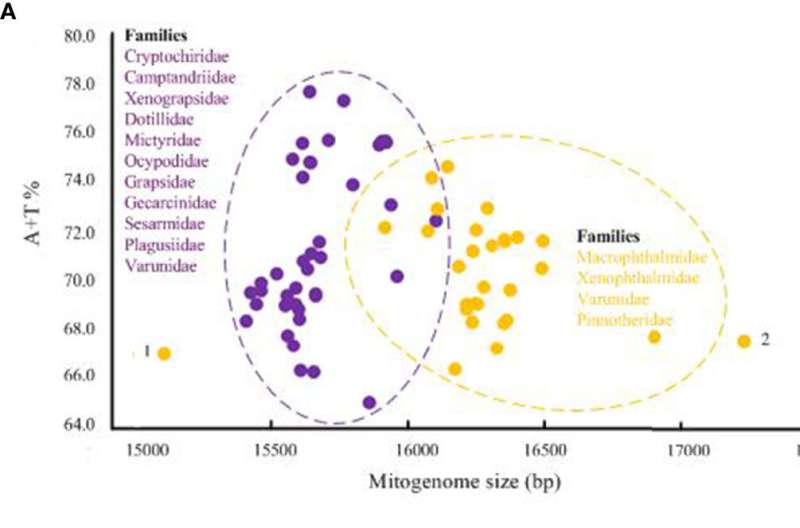Study reveals evolution of crab group Thoracotremata

Thoracotremata (Brachyura, Decapoda) is the most derived crab group, encompassing 1,248 extant species. It currently comprises four superfamilies: Grapsoidea MacLeay, Ocypodoidea Rafinesque, Cryptochiroidea Paulson and Pinnotheroidea De Haan.
As one of the most diverse crab groups with diversified lifestyles, the phylogenetic relationships of Thoracotremata are unclear.
Recently, a research team led by Prof. Sha Zhongli from the Institute of Oceanology of the Chinese Academy of Sciences (IOCAS) has revealed the evolution of mitochondrial gene order (MGO) among thoracotremes, and provided new insights into the internal phylogenetic relationships of Thoracotremata.
The study was published in Frontiers in Marine Science on April 14.
The researchers obtained twelve new mitogenomes from the four thoracotreme superfamilies, which enhanced the taxonomic coverage of Thoracotremata mitogenomic data. They also identified nine distinct patterns of MGO among thoracotreme mitogenomes, among which four MGOs were newly found.
The symbiotic groups, the cryptochiroid and pinnotheroid crabs, display variable MGOs, providing evidence for possible correlations of rearranged MGOs to the adaptation to specialized lifestyles.
The expanded Thoracotremata mitochondrial phylogenetic relationships were resolved for the first time. The Pinnotheroidea formed the basal monophyletic clade. Cryptochiroidea grouped with an ocypodoid lineage (Dotillidae/Xenophthalmidae/Camptandriidae) located at a more evolved position, indicating that commensalism may has evolved independently multiple times within Thoracotremata.
Moreover, the macrophthalmid crab Tritodynamia horvathi from Ocypodoidea was more closely related to the varunid crab Asthenognathus inaequipes from Grapsoidea, which supports the inclusion of Tritodynamica in the family Varunidae.
"The phylogeny of Thoracotremata and the phylogenetic position of Cryptochiroidea and Pinnotheroidea within Thoracotremata were first estimated using mitogenomic data by inclusion of representatives of all available thoracotreme superfamilies. This study also provides a novel insight towards understanding the internal phylogenetic relationships of the thoracotreme superfamilies," said Dr. Sun Shao'e, first author of the study.
"The phylogenetic relationship based on mitogenomes was of great value to the studies of biodiversity, origin and evolution, as well as biogeography in Thoracotremata," said Prof. Sha.
More information: Shao'e Sun et al, Mitogenomes Provide Insights Into the Evolution of Thoracotremata (Brachyura: Eubrachyura), Frontiers in Marine Science (2022). DOI: 10.3389/fmars.2022.848203
Journal information: Frontiers in Marine Science
Provided by Chinese Academy of Sciences



















